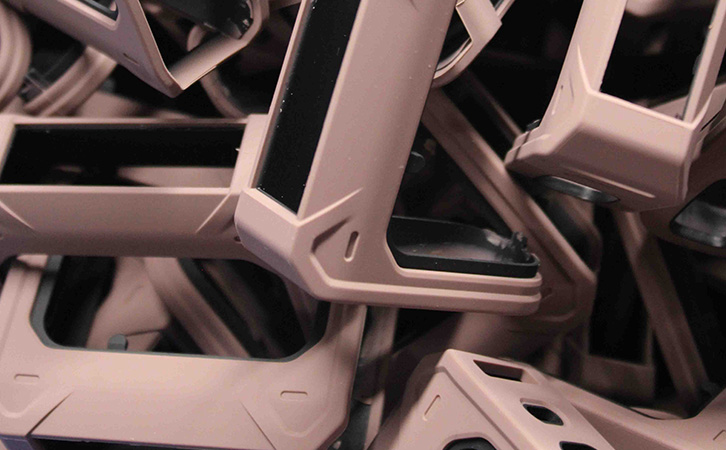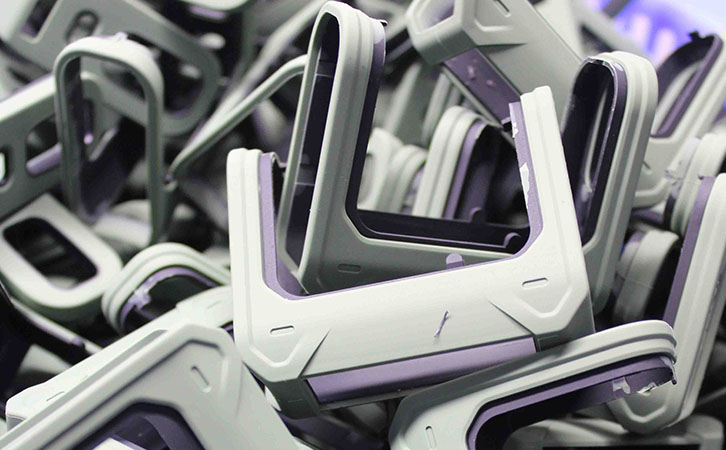Preparation materials and production process of liquid silicone rubber (LSR) wrapped plastic parts
Liquid silicone rubber (LSR) encapsulated plastic parts (Insert Molding/Injection Molding) is a process of using plastic parts as inserts and encapsulating them with liquid silicone injection molding. It is widely used in fields such as electronic waterproof sealing, medical treatment equipment, and automotive parts. The following is a detailed description of the preparation materials and production process:
1、 Prepare materials
1. Liquid silicone (LSR) material
A/B two-component liquid silicone gel: needs to be mixed in proportion (usually 1:1), with high fluidity, high temperature resistance, aging resistance and other characteristics.
Hardness selection: commonly Shore A 30~80, adjusted according to product requirements (such as 30A for soft touch buttons and 50A for sealing rings).
Color: Customized color paste can be added, ensuring that the color powder is evenly dispersed and does not affect vulcanization.
Special performance: such as medical treatment level (compliant with FDA/USP Class VI), food grade level (LFGB), flame retardant level (UL94 V0), etc.
2. Plastic inserts
Material: commonly used ABS, PC, PA (nylon), PBT, etc., temperature resistance (≥ 150 ℃) is required to avoid deformation.
Preprocessing:
Cleaning: Ultrasonic wave cleaning or plasma treatment to remove oil stains, release agents, and improve the adhesion of silicone.
Preheating: Some processes require preheating (80-100 ℃) to reduce deformation caused by thermal stress.
Surface treatment: Some materials require spraying primer or physical roughening (such as laser etching) to enhance adhesion.

Embedded positioning structure: fixed with card slots, magnetic suction or mechanical arms to prevent displacement.
Exhaust groove design: to avoid trapped air causing bubbles or burning.
Equipment:
Liquid silicone injection molding machine: equipped with A/B component metering and mixing system.
Mechanical arm/automatic feeding system: Place inserts to improve efficiency.
Sulfurization oven (optional): Secondary vulcanization enhances performance.
2、 Production process (key steps)
1. Pre processing of embedded components
Plastic parts cleaning → drying (optional) → surface treatment (such as spraying primer) → preheating (as required).
2. Insert the components into the mold
Manual/automatic placement: Mechanical or manual positioning of plastic parts into the mold cavity.
Mold closure: Ensure that the inserts are not loose, avoiding compression or displacement.
3. Liquid silicone injection molding
A/B component mixing: proportioning by metering pump (error ≤ 0.5%).
Injection molding: Low temperature (20-40 ℃) injection, high temperature (160-200 ℃) vulcanization, time 5-60 seconds (depending on product thickness).
Pressure holding cooling: Ensure that the silicone is completely cured without shrinkage marks or internal stress.
4. Mold opening and component retrieval
Top out demolding: Avoid strong pulling that may cause separation between silicone and plastic.
Preliminary inspection: Check the integrity of the coating and ensure there are no missing glue or burrs.
5. Post processing (optional)
Secondary vulcanization: Bake at 120-150 ℃ for 1-2 hours to improve the physical properties of silicone (such as resilience).
Deburring: Hand or frozen deburring.
Surface treatment: such as spraying anti fouling coatings.

6. Quality inspection
Adhesive strength test: 90 ° peel force ≥ 3N/mm (such as ISO).
Sealing test: Air tightness/water pressure testing (such as IP67/IP68).
Dimensional inspection: Compare 3D drawings with CMM or optical scanning.
Typical applications
Electronic waterproof: Silicone sealing ring for headphone charging compartment (plastic+LSR integrated molding).
Medical treatment equipment: Breathing valve (plastic frame+silicone membrane).
Automotive components: Sealing of wire harness connectors (PA66+LSR).
Through mold design and strict process control, high-quality products with high adhesive strength and seamless coverage can be achieved.

